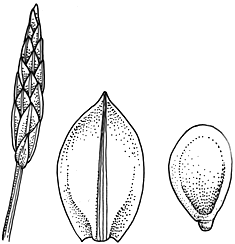Fimbristylis ferruginea (L.) Vahl APNI* Synonyms: Fimbristylis brevifolia R.Br. APNI*

Description: Tufted perennial with very short rhizome. Culms compressed, 20–80 cm high, 1.5–3 mm diam.
Upper leaves 2–10 cm long, 0.5–1.5 mm wide; lower leaves reduced to sheaths; ligule a dense fringe of short hairs.
Inflorescence simple or head-like, with 1–10 (rarely to 25) solitary spikelets, on branches to 3 cm long; involucral bracts leaf-like, 1 erect, usually shorter than inflorescence. Spikelets ovoid to oblong-ovoid, terete, acute, 5–20 mm long, 3–4 mm diam. Glumes spiral, ± papery, obtuse, mucronulate, with 1-nerved faint midrib, 3–4.5 mm long, often ciliolate on upper margins, appressed pubescent to scaberulous at least near the apex, rarely subglabrous, red-brown. Stamens 3; anthers 1–1.5 mm long. Style 2-fid, densely ciliate.
Nut biconvex, obovoid, shortly stipitate, 1–1.2 mm long, 0.7–1 mm diam., ± smooth, ± shining, pale to dark brown, with epidermal cells ± isodiametric.
Flowering: spring–summer.
Distribution and occurrence: Coast north from the Sydney region. Grows in brackish or fresh water coastal swamps.
NSW subdivisions: NC, CC
Other Australian states: Qld W.A. S.A. N.T.
Text by K. L. Wilson
Taxon concept: Flora of NSW 4 (1993)
APNI* Provides a link to the Australian Plant Name Index (hosted by the Australian National Botanic Gardens) for comprehensive bibliographic data
***The AVH map option provides a detailed interactive Australia wide distribution map drawn from collections held by all major Australian herbaria participating in the Australian Virtual Herbarium project.
|


